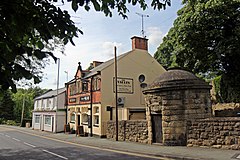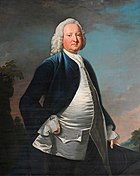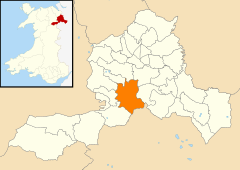Ruabon
This articleneeds additional citations forverification.(December 2011) |
Ruabon
| |
|---|---|
 The Vaults public house and the roundhouse, Ruabon | |
Location withinWrexham | |
| Population | 4,274 (2011 Census)[1] |
| OS grid reference | SJ303438 |
| Community |
|
| Principal area | |
| Preserved county | |
| Country | Wales |
| Sovereign state | United Kingdom |
| Post town | WREXHAM |
| Postcode district | LL14 |
| Dialling code | 01978 |
| Police | North Wales |
| Fire | North Wales |
| Ambulance | Welsh |
| UK Parliament | |
| Senedd Cymru – Welsh Parliament | |
Ruabon(Welsh:Rhiwabon;pronounced[r̥ɪʊˈɑːbɔn]) is a village andcommunityinWrexham County Borough,Wales.The name comes fromRhiw Fabon,rhiwbeing the Welsh word for "slope" or "hillside" andFabonbeing a mutation fromSt Mabon,the original church name, of earlier, Celtic origin. An olderEnglishspelling,Rhuabon,can sometimes be seen.
In 2001, more than 80% of the population of 2,400 were born in Wales, with 13.6% having some ability in Welsh.[2]
Early history
[edit]There is evidence that a settlement existed in Ruabon in theBronze Age.In 1898, building works in the centre of Ruabon exposed acistor stone urn containingcrematedhuman remains dating from 2000 yearsBC.In 1917, the remains of a Bronze Ageround barrowwere discovered on the playing fields ofRuabon Grammar School;they contained human remains, aflint arrowheadand a bronze axe.
Overlooking Ruabon, the Gardden (Welsh:Caer Ddin) is an ancienthillfortsurrounded by circular ditches, dating back to theIron Age.[3]
The old parish
[edit]

The ancientparishof Ruabon was made up of the townships of Ruabon (which also included the hamlets of Belan, Bodylltyn, Hafod and Rhuddallt), Cristionydd Cynrig (also known asY Dref FawrorCristionydd KenrickinEnglish), Coed Cristionydd, Cristionydd Fechan (also known asY Dref FechanorDynhinlle Uchaf), Dinhinlle Isaf; Morton Anglicorum (the “English Morton” or Morton Below the Dyke) and Morton Wallichorum (the “Welsh Morton” or Morton Above the Dyke).
In 1844, Coed Cristionydd and part of Cristionydd Cynrig became part of the new parish ofRhosymedre,and Cristionydd Fechan and Moreton Above became part of the new parish ofRhosllannerchrugog. Later in 1879, Dynhinlle Uchaf and the remainder of Cristionydd Cynrig became the new parish ofPenycae.
Ruabon is within thehistoric countyofDenbighshireand, between 1889 and 1974, was administered byDenbighshire County Council.From 1974 until 1996, it was administered as part ofClwyd.From 1996, it has been administered as part of the County Borough of Wrexham.
St Mary'sis aGrade I listedchurch, in the churchyard between Bridge Street and Church Street. Included in the listing is the lych gate and churchyard walls. The church is listed on the National Monuments Record of Wales.[4][5][6][7]The parish is in theMission Area of Offain theChurch in WalesDiocese of St Asaph.[8]
Wild Wales
[edit]In the 1850s the English writerGeorge Borrowtoured Wales and wrote an account of his journey in the bookWild Wales:
- “Rhiwabon… a large village about halfway betweenWrexhamandLlangollen.I observed in this place nothing remarkable, but an ancient church. My way from hence lay nearly west. I ascended a hill, from the top of which I looked down into a smoky valley. I descended, passing by a great manycollieries,in which I observed grimy men working amidst smoke and flame. At the bottom of the hill near a bridge I turned round. A ridge to the east particularly struck my attention; it was covered with duskyedifices,from which proceeded thundering sounds, and puffs of smoke. A woman passed me going towards Rhiwabon; I pointed to the ridge and asked its name; I spoke English. The woman shook her head and replied "Dim Saesneg"(English:" No English ")." This is as it should be ", said I to myself;" I now feel I AM in Wales. "
The Wynns of Wynnstay
[edit]The Williams-Wynn family were major landowners in north and mid-Wales and also across the English border. For centuries they had a great influence on the political, cultural, social and literary life of Wales. Although the family owned several houses throughout Wales, the seat of the family was atWynnstayin Ruabon. The fifthbaronetbecame so powerful that he was given the unofficial title of "The Prince IN Wales".
Wynnstay had passed into the possession of the Wynn family (as they were then known) through marriage. The estate, originally known simply asRhiwabon,was owned by the Eyton family who later changed its name to "Watstay". On inheriting the estate, SirWatkin Williams-Wynntook on the additional surname of Wynn and commissioned the building of a newmansion,to be known asWynnstay,to replace the original building.

The arms of the Williams-Wynn family show an eagle with the Welsh motto "Eryr Eryrod Eryri"which translates into English as" The Eagle of Eagles of the Land of Eagles ", the" Land of Eagles "beingSnowdoniaand reflecting the family's origins in that part of Wales.
One of Wales’ greatestharpistswas under thepatronageof the Williams-Wynns.John Parry( “John Parry Ddall, Rhiwabon” ) was born in about 1710 on Pen Llyn and was blind from birth. He lived on the Wynnstay estate but spent much of his time at the family'sLondonhome where he performed on the Welshtriple harpfor London's cultural elite.
Parts of the grounds were landscaped byCapability Brownand the park was regarded as one of the largest and most important in Wales, containing several important monuments: a column byJames Wyatt,erected in 1790 as a memorial to the fourth baronet; the Nant y Belan Tower and theWaterloo Tower.
In 1858, the ‘old’ Wynnstay was destroyed by fire, with many valuable manuscripts being lost.Sir Watkinbuilt a new mansion on the same site. During theSecond World Warthe hall and part of the park became theheadquartersfor theRoyal Engineers Survey,a specialist branch of the RE responsible for providing training forsapperswho staffed the mobile Map Production units which were part of allBritish Armyoperations. RE Survey moved out in 1946. There was also a fire in the stables adjoining the hall during the same War while the hall was used asbilletingfor officers.
Because of heavydeath duties,the Williams-Wynns moved from Wynnstay to nearby Plas Belan, a house in the estate grounds, and finally left Ruabon forever in 1948, severing a link with Ruabon of over two centuries. Lady Daisy Williams-Wynn continued to live at Belan for much longer than 1948. Much of the estate was put up for sale and the house became aprivate school,Lindisfarne College(which took its name from the island ofLindisfarneinNorthumberlandalthough it had no connection with the island). The school itself closed in bankruptcy in 1994 and the house was converted into luxury flats.
The organ at Wynnstay was built byJohn Snetzlerin 1774 forSir Watkin Williams-Wynn's London home inSt James's Squarebut was moved to Wynnstay in 1863. During the sale of Wynnstay and its contents, the organ, and many other treasures, were acquired for thenationand are now displayed at theNational MuseuminCardiff.
The woodlands within the estate were taken over by theForestry Commissionand the trees were felled and replaced byconifers.Further destruction took place when parts of the estate grounds were built over during the construction of the Ruabonbypass.
Industry
[edit]This sectionneeds additional citations forverification.(September 2022) |
Iron works, coal mines and chemical works
[edit]The Ruabon area was once heavily industrialised with large deposits ofiron,coalandclay.Iron was worked in Gyfelia and Cinders as far back as theMiddle Agesbut heavy industry dominated the entire parish in the 18th and 19th centuries. Coal was extracted frompitsat the Green,Plas Madoc,Plas Bennion,Wynn Hall,Afon Eitha, Cristionydd, Groes, Plas Isaf, Plas Kynaston, Gardden, Brandie, Aberderfyn,Ponkeyand Rhos, but many of these were hit by flooding in 1846 and ceased production. Later collieries were built at Wynnstay, Vauxhall and Hafod.Hafod Collierywas sunk in 1867 to replace the former Wynnstay Colliery (whose Engine House and Fan House can still be seen on either side of the B5605 to Rhosymedre) after flooding caused it to close in the 1850s. Hafod, at first called New Ruabon Colliery, was once the biggest employer in the area. It closed in 1968. The colliery's coal tip has since been preserved asParc Bonc yr Hafod.The last colliery to work the Ruabon coalfield wasBersham,which at one stage connected with Hafod underground, and closed in December 1986.
Iron was worked at Ruabon,Acrefair,Cefn Mawrand Plas Madoc, andzincat Wynn Hall. One of the main companies was theBritish Iron Companyand their successors, the New British Iron Company, who operated ironworks and collieries at Acrefair from 1825 to 1887. In 1867 Robert Graesser, an industrialchemistfrom Obermosel inSaxony,Germany, established a chemical works at Plas Kynaston in Cefn Mawr to extractparaffinoil and wax from the localshale.This was the start of the long association between the chemical industry and Cefn Mawr.
Much of the mineral wealth of the area was exported by canal over thePontcysyllte Aqueducton theShropshire Union Canal,until the railway reached Ruabon in 1855. The site was later acquired by the American chemical companyMonsanto,their first venture in Europe, but in 1995 it was sold and renamed Flexys, a specialist in chemicals and additives for the rubber industry. The site was later operated asSolutia[9]but closed in 2010.
Brick and clay works
[edit]At Afongoch there were three clay companies very close together:
- Monk & Newell was on the east side of the Ruabon–Wrexham road. It closed in the 1920s and the site was later used for housing (Newell Drive) and the adjacent floodedclay pit(Monk's Pool) is now used by a localanglingclub.
- TheRuabon Brick & Terra Cotta Ltd(also known as Jenks'TerracottaWorks or Gwaith Jinks) was on the west side of the Ruabon–Wrexham road (off Tatham Road) with its original clay pit to the east of the road, separated from the Monk & Newell clay pit by the Afon Goch. Founded by the Hague family of the Gardden in about 1883 and managed by Henry Jenks, it produced bricks, chimney pots,finials,cornicesandencaustic tiles.It was taken over by Dennis' in the 1960s but closed in the mid-1970s. The works site is now an industrial estate as is the original clay pit.
- The Tatham Brick & Tile Works or Afongoch & Tatham Tileries was at Afongoch, on the west side of the Ruabon–Wrexham road, off Tatham Road. Opened about 1860 by Henry Richard Bowers & Co. of Penbedw, Acrefair, it produced bricks, pipes andchimney pots.It closed about 1910 when the clay pit was taken over by Jenks' Terracotta Works. The clay pit is now occupied by a closedlandfillmanaged byFCC Environment.
At Hafod, theCornishengineer Henry Dennis founded a clay works next to the Hafod Colliery. The Dennis Company became world-famous for its tiles and still operates today.
At Cinders, the Wynnstay Brickworks was to the right of the Ruabon–Overtonroad near Cinders Farm. It produced bricks, tiles and drainage pipes for the Wynnstay estate.
Other large brickworks existed atPant-yr-Ochain,Rhos, Acrefair,Treforand Newbridge.
Railways
[edit]Ruabon railway stationis on theShrewsbury to Chester linewhich was formerly part of theGreat Western RailwayfromLondon PaddingtontoBirkenhead Woodside.Transport for Walesservices operate from Ruabon to destinations includingCardiff,Birmingham,Chester,LlandudnoandHolyhead.Former services included theWrexham & Shropshireservice toLondon Marylebone.The railway here was also the junction to the now-closedRuabon–Barmouth line,along sections of which now run theLlangollen Railway,Bala Lake Railwayand theMawddach Trail,now a cycle track.
Until the 1960s, most of the local industries were connected to one or other of the main lines, or to theRuabon Brook Tramway(or one of its branches) which followed a route further North between Trevor and Wrexham viaRhosllannerchrugog.
SSRuabon
[edit]TheBritish merchantshipRuabon,a steamer of 2,004gross register tons(GRT), was captured and sunk byGermanU-boatU-20on 2 May 1916. The ship wastorpedoedabout 160 miles/258 km W by S of the island ofUshantinBrittanyen route fromSeville,SpaintoTroon,Scotland.The ship was owned by John Cory & Sons of Cardiff.
Offa's Dyke
[edit]Substantial remains ofOffa's Dyke(Welsh:Clawdd Offa) can be seen on the western outskirts of Ruabon. This massive earthwork, stretching fromChepstowin the south toPrestatynin the north, is associated withOffa,the 8th-century king ofMercia,and marked the boundary betweenSaxonMercia andCelticWales.
Traces of an earlier dyke,Wat's Dyke,can be seen on the eastern side of Ruabon. It would be several centuries before the lands to the east of Offa's Dyke would be returned to Wales.
Governance
[edit]Ruabon is also the name of anelectoral wardtoWrexham County Borough Council,though the ward only covers the northern part of the community. The southern part of the community (including the south of the Ruabon village) is covered by the Penycae and Ruabon South ward.[10]Each ward elects a county councillor.
Education
[edit]Ruabon's first school was the Endowed Grammar School, founded in the early 17th century close to the church. This school later became theRuabon Grammar Schooland eventually moved to the outskirts of Ruabon, near Mill Farm. Ruabon Grammar School provided education for boys in the parishes of both Ruabon andErbistockfor several centuries.
In 1922 a girls'grammar schoolwas built, using temporary accommodation, on a site adjacent to the boys' school but they had to wait until 1962 before a permanent school was built nearby. In 1967 both the boys' and girls' grammar schools merged to formYsgol Rhiwabon,aComprehensive School.
TheRuabon National School,aChurch of Englandfoundation, was built on Overton Road in the late 1840s. It later became St Mary'sChurch in WalesSchool and was completely rebuilt on the same site in 1976.
To cope with an expanding population another school was provided byDenbighshireEducation Committee on Maes y Llan and opened in 1912. This later became Ysgol Maes y Llan. It was always known as the Council School.
Lindisfarne College,an independent school, moved fromWestcliff-on-SeainEssexto Wynnstay in 1950. The school closed, through bankruptcy, in 1994.
Modern day
[edit]The village is home to pubs, small shops and a post office on its high street. A late 17th-century prison orlockupstill exists next to the Vaults public house. These were common in rural areas in the 18th and 19th centuries often next to public houses where miscreants were detained while awaiting transport to the nearest town.[11]As of July 2012, an old industrial unit on the former Ruabon Industrial Estate has a planning application submitted by developersCapital & Centric Plcfor a new supermarket on the disused site, potentially creating 300 jobs for the area.[12][needs update]Ruabon is served by theA483trunk road which bypasses the settlement just to the east.
Notable people
[edit]
- Sir John Wynn, 1st Baronet(1553–1627), Welsh baronet, MP and antiquary.[13]
- Sir Watkin Williams-Wynn, 3rd Baronet(ca.1692 – 1749), politician and landowner.[14]
- John Downman(1750–1824), portrait and subject painter.[15]
- Llewellyn Cadwaladr(1857–1909), operatic tenor, earlyGilbert and Sullivanperformer
- Isaac Daniel Hooson(1880–1948), poet and novelist, went toRuabon Grammar School
- Howard Saint(1893–1976), First World Warflying ace
- Meredith Edwards(1917–1999), character actor and writer
- Will Roberts(1907–2000), a Welsh industrial artist and expressionist painter
- Alex Carlile, Baron Carlile of Berriew(born 1948), barrister, crossbenchpeerand MP forMontgomeryshire,1983 to 1997.

Sport
[edit]- Walter Clopton Wingfield(1833–1912), inventor, British Army officer and pioneer oflawn tennis
- Llewelyn Kenrick(1847–1933), the"Father of Welsh football",born inWynn Hall
- BrothersDavid Thomson(1847-1876) andGeorge Thomson(1853-1937), Wales international footballers
- Alfred Payne(1849-1927), cricketer, died at Pen-y-Nant
- Charles Taylor(1863–1915), Royal Navy officer and rugby union player, killed in WWI
- Ted Hughes(1876-??), footballer with over 150 club caps and 14 forWales
- Lloyd Davies(1877–1957), footballer with 345 club caps and 16 forWales
- Mark Hughes(born 1963), football manager and former player with 606 club caps and 72 forWales
See also
[edit]- Pen-Y-Lan Hall,agrade II listed[16]Regency gothicmansion located within the Ruabon parish
References
[edit]- ^"Community population 2011".Retrieved19 November2015.
- ^2001 Census
- ^Hillfort
- ^"GENUKI: St Mary's, Ruabon".Retrieved4 September2024.
- ^"NMRW: St Mary's, Ruabon".Retrieved4 September2024.
- ^Cadw."Church of St Mary, including churchyard walls and lych gate (1622)".National Historic Assets of Wales.Retrieved4 September2024.
- ^"Church of St Mary, including churchyard walls and lych gate".British Listed Buildings.Retrieved4 September2024.
- ^"St Marys, Ruabon".Retrieved4 September2024.
- ^"Ruabon Works – Flexys site with links to Solutia".Retrieved22 June2009.
- ^"Election Maps".Ordnance Survey.Retrieved21 February2021.
- ^"The Round House, Ruabon – Wrexham History".Archived from the original on 26 September 2020.Retrieved1 September2022.
{{cite web}}:CS1 maint: unfit URL (link) - ^Boyd, Andrew (31 January 2012)."New supermarket could create up to 300 jobs".The Leader.Retrieved6 June2018.
- ^.Encyclopædia Britannica.Vol. 28 (11th ed.). 1911. p. 873.
- ^.Encyclopædia Britannica.Vol. 28 (11th ed.). 1911. p. 686.
- ^Williamson, George Charles(1911)..Encyclopædia Britannica.Vol. 8 (11th ed.). pp. 459–460.
- ^"British Listed Buildings".Retrieved4 May2011.
Sources
[edit]- A. N. Palmer,The History of the Parish of Ruabon
- George Borrow,Wild Wales,1862
- G. G. Lerry,Collieries of Denbighshire,1968
- T. W. Pritchard,Remembering Ruabon – Cofio Rhiwabon,2000
- National Museum of Wales





